By Roy Morris Jr.
Peering through the predawn darkness at the slowly emerging shoreline 300 yards away, the little man with the famous name prepared once again to set foot in France as a soldier of the liberation. As the time neared 6:30 am on D-day, June 6, 1944, Brig. Gen. Theodore Roosevelt, Jr., would not have wanted to be anywhere else.
Indeed, Roosevelt had been forced to beg repeatedly for the opportunity to land with his soldiers on Utah Beach. As he explained to his immediate superior, Maj. Gen. Raymond O. “Tubby” Barton, commanding officer of the 4th Infantry Division, “It will steady the boys to know I am with them. They’ll figure that if a general is going in, it can’t be that rough.”
Now, bobbing alongside the troops in a wildly careening LCVP, Roosevelt gripped the walking cane he used to get around on his bum left knee—the unwelcome souvenir of a German machine-gun bullet he had taken at Ploisy, near Soissons, in July 1918. He had already used his cane to fend off the well-intentioned assistance of one of his men as they got ready to jump into the landing craft from their transport ship Bayfield, 11 miles off the French coast. “Get the hell out of my way,” Roosevelt had growled good-naturedly. “I can jump in there by myself. I can take it as well as any of you.”
No one who knew Ted Roosevelt doubted the truth of that statement. At 57, he was the oldest man in the entire Allied invasion force now in the midst of storming ashore on the northern coast of France in the greatest amphibious assault in military history. He would be the only general to personally hit the beach on D-day, a fitting feat for the first-born son of the legendary adventurer who had led his fabled Rough Riders up San Juan Hill almost exactly 46 years earlier.
The Roosevelts, father and son, always led from the front, a trait that had nearly cost the younger Roosevelt his star the year before. The Army’s II Corps commander, Lt. Gen. Omar Bradley, had removed Roosevelt and his immediate superior, Maj. Gen. Terry Allen, from command of the 1st Infantry Division for taking unnecessary personal risks and for “wantonly sacrificing their men” in a reckless frontal assault at Troina, Sicily.
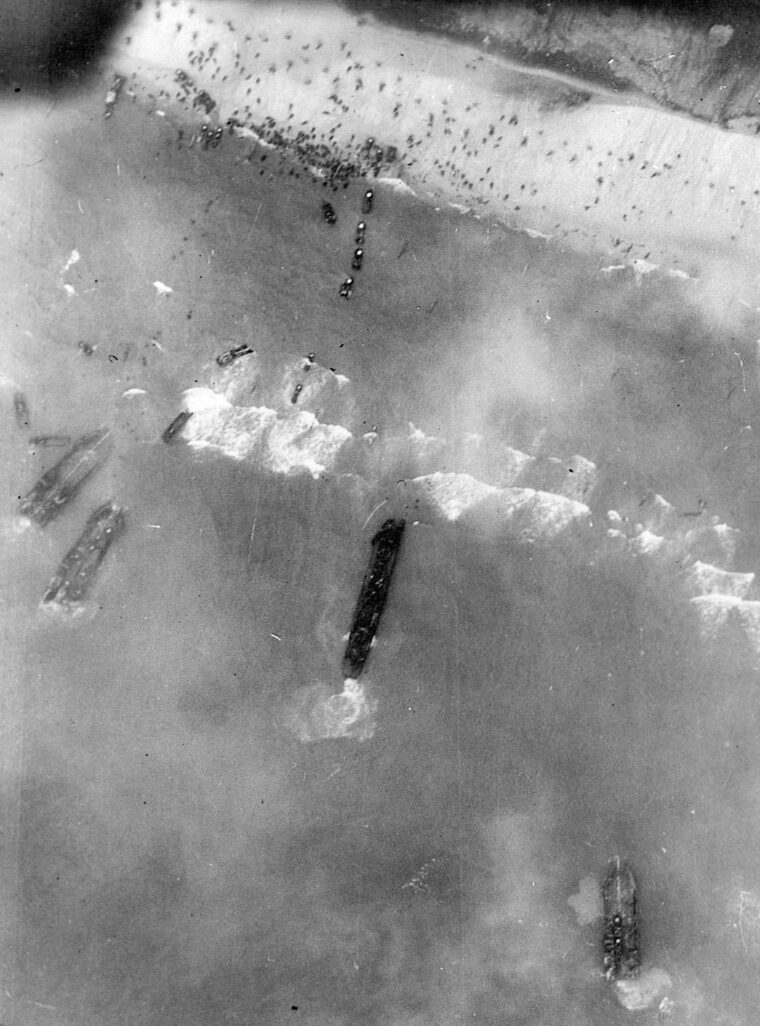
Eleven months later, the unlucky Allen remained in professional limbo, but Bradley transferred Roosevelt to the 4th Infantry Division in England, where he helped the Allied high command prepare for the upcoming invasion of Nazi-held France. Roosevelt was uncomfortably aware that he still labored under something of a cloud, both personally and professionally. Fellow general George S. Patton, himself no slouch when it came to taking chances in the heat of battle, echoed the party line at Army headquarters when he described Roosevelt as an officer having “great courage, but no soldier.”
Roosevelt would soon have the opportunity to test both parts of Patton’s terse evaluation under the most trying of battlefield conditions. As 175,000 Allied troops began thrashing through the surf toward France’s Normandy coast at H-hour on D-day, Roosevelt gathered himself mentally and physically for the challenge ahead. By all rights, he should have been back on the Bayfield, or even back in England itself. Not only was he 57 years old, with a permanent limp from an old bullet wound and severe arthritis in his shoulders and arms, but he also had a bad heart, something he had kept secret from both his family and his fellow officers. He was suffering from fibrillations, irregular heartbeats that frequently left him breathless and weak. It was a potentially life-threatening condition, although just now, with German bullets zinging overhead and artillery shells dropping onto the beach in front, a fatal heart attack was the last thing on Roosevelt’s mind.
A hundred yards from the sandy stretch designated Utah Beach by Allied war planners, the game little general dropped into the water, walking stick in one hand and silver-plated .45-caliber pistol in the other. Like his father in Cuba, Roosevelt had reached his “crowded hour.” It would be a fateful moment for both the general and his troops.
Utah Beach, an unexceptional stretch of sand dunes and sea oats nine miles long and centered on the Nazi strongpoint at Les-Dunes-de-Varreville, was located at the far western end of the Allied line. West to east, the intended landing zones were designated Utah, Omaha, Gold, Juno, and Sword Beaches. Already, the main American objective, Omaha Beach, was the focus of a brutal, swirling firestorm, as German defenders blazed away with machine guns, artillery, mortars, grenades, rockets, and small arms. Smoke from the gunfire hung darkly in the sky. It was obvious that the initial wave of assault troops there was taking a heavy pounding.
As Roosevelt and the 4th Infantry came ashore on Utah Beach, Nazi resistance was limited to a few desultory volleys from riflemen of the 919th Regiment concealed in trenches behind the four-foot-high concrete seawall in front of La Madeleine, a landmark dune in the middle of the beach. A fortuitous combination of unforeseen circumstances—the loss of control vessels to guide the assault, a thick cloud of smoke from supporting Allied naval fire, and a strong tidal current sweeping everything to the west—had forced the division’s 20 LCVPs over a mile south of their original objective.
Roosevelt, to his credit, immediately recognized the error. He located Captain Howard Lees, commander of E Company, 2nd Battalion, 8th Infantry, crouched at the top of a sand dune with his men. Peering at their maps, the general and the captain quickly situated themselves as German 88mm cannon shells began raining down from the sand-peppered sky. “Hey, this doesn’t look like what they showed us,” Lees said, referring to the tabletop model the officers had trained on back in England. Roosevelt told him to sit tight and calmly walked back down to the beach to reorient himself.
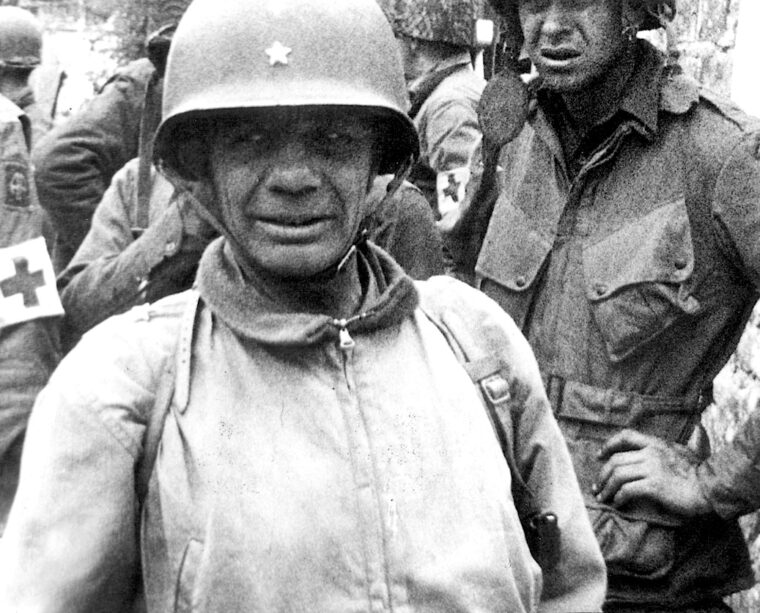
By now, the lead troops of the 4th Division were beginning to bunch up, as successive waves of LCVPs pitched their load of men, sputtering and thrashing, into the rough seas 100 yards offshore. Sergeant Harry Brown caught sight of the general, wearing a green woolen knit cap—he hated wearing a helmet—strolling along “with a cane in one hand, a map in the other, walking around as if he was looking over some real estate.” Sand showered down on Roosevelt from artillery explosions, but he only brushed the dirt impatiently from his shoulders and kept walking. One shell, landing uncomfortably close by, caught a group of American soldiers broadside as they were wading ashore. A dozen men went down, and a lone figure emerged from the smoke and staggered onto the beach, his face blackened and his eyes staring. Roosevelt yelled for a medic and ran over to the shellshocked man. Putting his arm around the man’s shoulders, he spoke gently to him. “Son,” he said, “I think we’ll get you back on a boat.”
As more German shells plunged onto the beach, Roosevelt jumped into a nearby foxhole for safety. It was a lucky choice: He landed atop Commodore James Arnold, the Navy control officer for Utah Beach. Together, the two ranking officers assessed the situation. Soon there would be over 22,000 men and 1,800 vehicles—tanks, trucks, and jeeps—bunched up behind them. The division’s primary objective was to seize the major causeways leading inland from the beach toward Ste.-Marie-du-Mont and Les Forges and link up with troopers from the 82nd and 101st Airborne Divisions, who had dropped behind German lines the night before to secure the high ground around St.-Martin-de-Varreville and Ste.-Mere-Eglise. Once clear of the beach, the American units would drive northward along Route N17 toward the vital port of Cherbourg, linchpin of the entire Cotentin Peninsula, which thrust outward into the Atlantic like a giant thumb.
The problem, which Roosevelt and Arnold immediately recognized, was that the misplaced landing had planted the first wave some 2,000 yards south of their intended location. Instead of coming ashore above La Madeleine, where the causeways known as Exits 3 and 4 came together on the beach road, the 4th Division had landed at La Grande Dune, just above Exit 2. The question was whether to funnel the entire division onto the single exit where they were coming ashore, or whether to move—or attempt to move—the men a mile northward to the original site.
Roosevelt, Arnold, Colonel James Van Fleet, and Lt. Cols. Conrad Simmons and Carlton MacNeely held a hasty council of war in Arnold’s foxhole. It was Roosevelt’s decision to make, and he made it without hesitation. “I’m going ahead with the troops,” he said. “Get word to the Navy to bring them in. We’ll start the war from here.”
That said—and it was a saying that would make Roosevelt famous—the general began organizing the drive toward Exit 2. Continuing to exhibit total disregard for his own safety, Roosevelt paced back and forth from the seawall to the surf, grabbing officers and enlisted men and heading them in the right direction. Lt. Col. Arthur Teague, commander of the 3rd Battalion, 22nd Regiment, plowed ashore on a landing craft that hit the beach at full speed. With German shells dropping 75 yards behind him, Teague began stumbling toward the seawall when he heard someone shouting his name. It was Roosevelt.
“He told me we had landed way to the left of where we were supposed to have landed and he wanted us to get this part of the beach cleared as soon as possible,” Teague recalled. “He wanted action from my men immediately after landing and asked me to get them down the beach as soon as I could.”
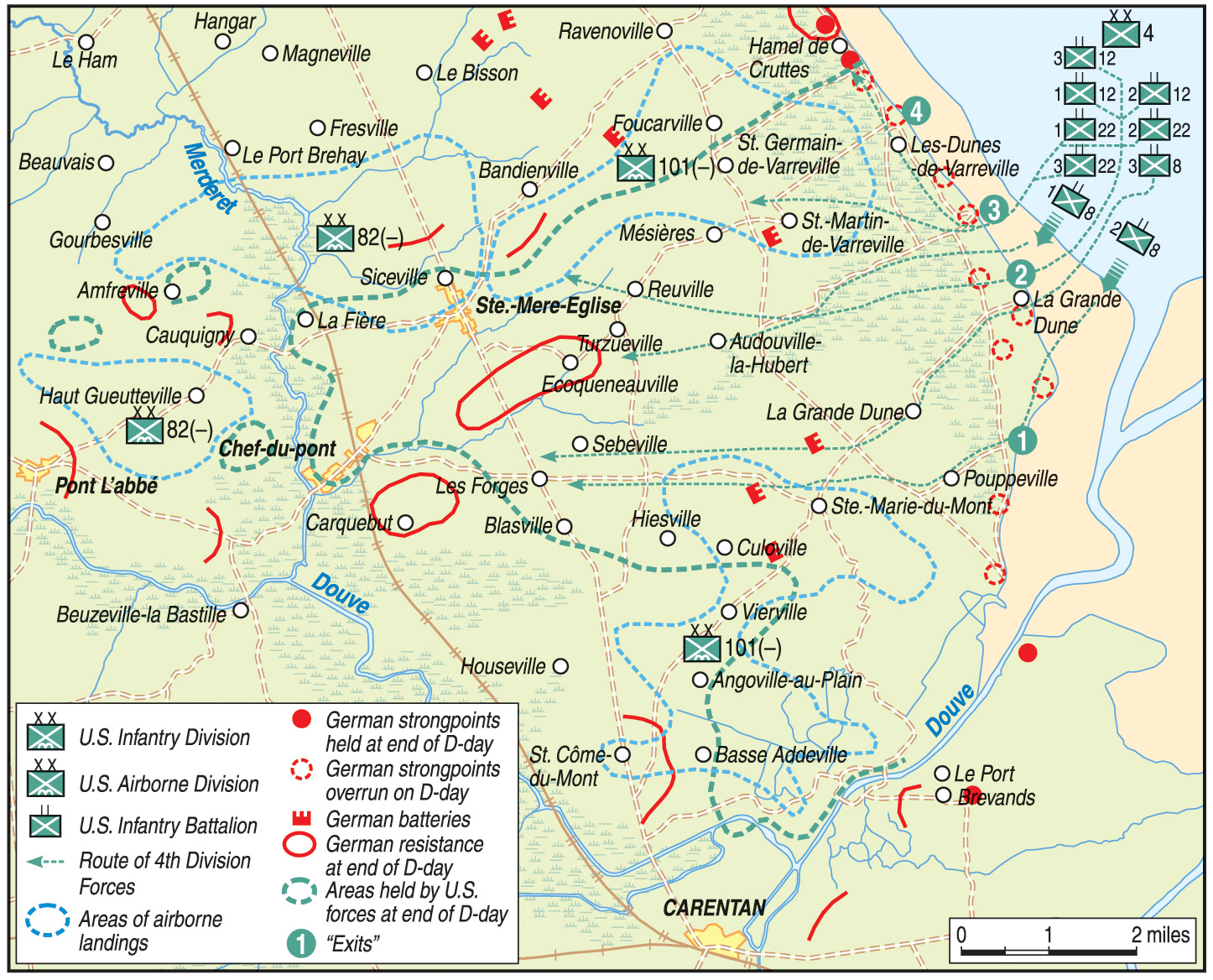
Teague obeyed at once, throwing out a skirmish line that rousted a handful of German soldiers from a trench behind a sand dune. Meanwhile, advancing Americans began stepping on land mines the enemy had sprinkled under the marshy ground beyond the beach. The captured Germans professed ignorance of any mines until Teague forced them at gunpoint to accompany the skirmishers inland. Then the prisoners suddenly remembered where the mines were located, and Teague’s men were able to tiptoe their way safely past the minefield.
Behind them, on the beach, Army engineers and Navy Seabees were planting explosive charges to clear the way for half-tracks and tanks to offload from their LSTs. The engineers had arrived in the second wave, jumping off their landing craft into waist-deep water. Each man carried between 50 and 75 pounds of TNT or plastic explosives on his back, along with several cartons of cigarettes they had been issued just before departing. To lighten their loads, the men reluctantly jettisoned their cigarettes.
“We were wading in cigarettes up to our knees,” Sergeant Richard Cassiday of the 237th Engineer Combat Battalion remembered. Cassiday set to work planting charges near the seawall. He was about to detonate an obstacle when he saw a familiar figure walking nearby with a cane. “Go knock that bastard down, he’s going to get killed!” Cassiday shouted. “Somebody said, ‘Do you know who that is?’ I said, ‘Yes, it’s Roosevelt, and he’s going to get killed.’” The general moved on, unconcerned, just before the charge went off.
Not everyone was as lucky as Roosevelt. Captain George Mabry of the 2nd Battalion, 8th Regiment, landed with the third wave at Utah Beach. Thrashing through the cold, waist-deep water, Mabry alternately battled cramps and enemy rocket fire. “Just before I got out of the water,” he recalled, “Corporal Speck, one of my baseball players when I coached the team at Fort Benning, was lying there. He had been hit in both legs. I reached down to help him but he stopped me. He said, ‘Captain, your place is inland. Leave me alone and get moving.’ It was a tough thing to do, to leave him. But he kept insisting my place was inland. I moved forward.”
On the beach, Mabry saw a mortar round hit a fellow soldier squarely on the top of the head. The man was carrying an armful of 81mm mortar ammunition, and the enemy round caused the ammunition to detonate. The man’s body instantly disappeared, and Mabry felt something hit him on the thigh—it was the man’s thumb; nearby lay his stomach. “No one dead or alive was near it,” Mabry said. “It was a stark, grotesque sight.”
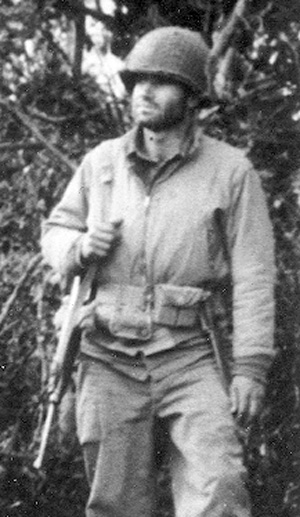
Farther inland, Mabry caught sight of Roosevelt, waving his inevitable cane and urging the new arrivals to keep moving forward. Climbing a sand dune, Mabry saw a group of five Germans suddenly jump up and begin firing at him. He returned fire, killing a Nazi who was about to fling a potato-masher grenade at him. The other four immediately, if unexpectedly, surrendered. Mabry handed them over to a wounded corporal and kept going.
It was now midmorning, and the German resistance at Utah Beach was crumbling. Mabry, who would later win the Medal of Honor in the Hurtgen Forest, gathered a handful of men from G Company, 2nd Battalion, including a crack shot named Ballard armed with a Browning Automatic Rifle (BAR), and headed for an enemy pillbox guarding the entrance to the causeway at Exit 1. The group was joined by two Sherman tanks from the 70th Tank Battalion, which had just trundled ashore.
Diving into a ditch to avoid German machine-gun fire, Mabry ordered Ballard to spray the emplacement with a burst from his BAR. It was met with return fire from the pillbox. The tanks joined in the fray, and after a shell penetrated one of the pillbox’s slit openings, a white flag poked out of the embrasure. Thirty-six Germans surrendered. They were soon joined by another 25 prisoners who capitulated to an American flamethrower. Exit 1 was now open.
Mabry, a 1940 graduate of Presbyterian College in South Carolina, continued his advance down the causeway. Together with Sergeant Malvin Pike of E Company, the industrious young lieutenant came to a hedgerow bordering a field surrounded by a barbed-wire fence. Suspecting the field was mined, Mabry recalled being taught in England “that if a length of straight wire extended skyward from the corner posts, the minefield was a dummy … if the wire curled like a corkscrew, it was a live field. I saw a straight line extend from the corner post closest to us.”
Testing the quality of his training, Mabry crawled under the wire and into the field—it was unmined. Continuing on, the two Americans came under fire from Germans on the other side of a flooded field opposite the causeway bridge. They returned fire, dropping two of the enemy within 10 yards of the bridge. More Germans appeared on the right of the causeway, attempting to outflank Mabry and Pike, but shots from the opposite side of the hedgerow—it sounded like M-1 rifle fire to Mabry—drove the Germans back. Mabry dashed across the bridge, where he spotted a huge aerial bomb wired to the span. “The Germans we had shot had probably been on their way to blow the bridge,” he thought later.
On the other side of the bridge, Mabry encountered a squad of would-be defenders cowering in a ditch on the side of the road. Eight more Germans surrendered personally to the brash young Southerner. Sending them back toward the beach under a white flag, Mabry and Pike pushed on across the flooded area toward the village of Pouppeville. Catching sight of a helmet disappearing into some bushes at the other side of the field, Pike raised his rifle to fire. Mabry held him back.
“You know,” he said, “the paratroopers are supposed to have taken this town. Let’s not shoot any of our paratrooopers.” Just then an orange flare shot up from behind the bushes—a sign of friendly troops. Mabry waved a piece of orange cloth in reply. Two soldiers wearing American flag patches on their shoulders rose warily from their cover. One of them, Lieutenant Eugene Brierre of the 101st Airborne, took note of the distinctive four-starred shoulder patch on the other men’s uniforms.”Fourth Division?” he asked. “Yes,” said Mabry. “Who’s in charge here?” Brierre replied. “I am,” said Mabry. “Well, General Taylor is right back here in Pouppeville and wants to meet you,” said Brierre. Just then, Maj. Gen. Maxwell Taylor, commander of the 101st Airborne, climbed through the hedgerow, returned Mabry’s crisp salute, and shook his hand. It was 11:05 am. The infantry and the airborne had made their first contact in France.
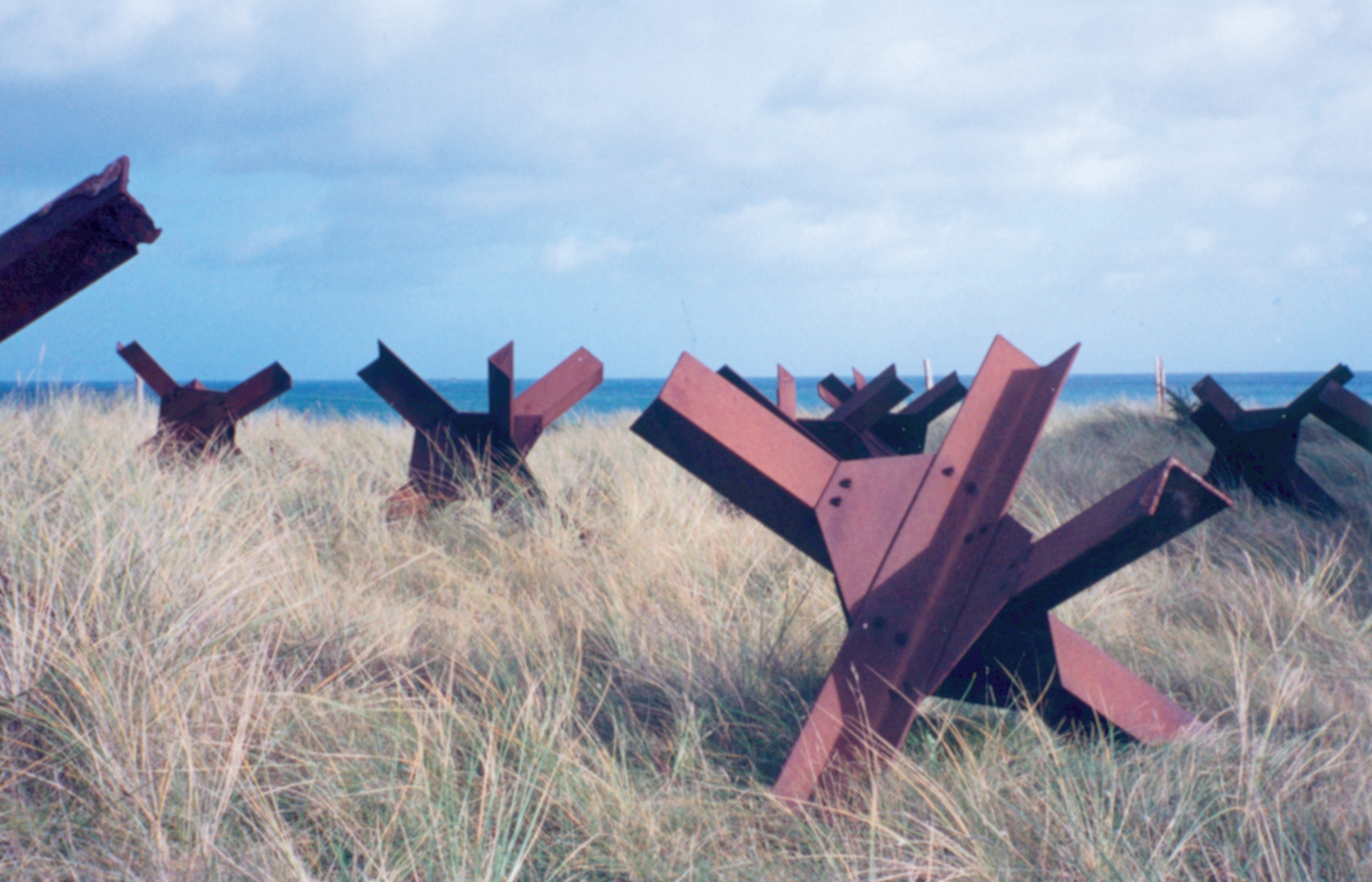
vehicles.
Soon more 4th Division troops began moving up the causeway into Pouppeville. One scout, carrying his rifle like a squirrel gun, came across Sergeant Thomas Bruff of the 101st Airborne. “Where’s the war,” he called good-naturedly. Bruff, who had landed eight miles from his intended drop zone the night before and had fought all night with a group under the personal command of General Taylor, was in no mood for pleasantries. “Anywhere from here on back,” he growled. “Keep going, buddy, you’ll find it.”
Meanwhile, three miles north, Colonel Russell “Red” Reeder pushed inland with his 12th Infantry Regiment. His immediate objective was St.-Martin-de-Varreville, where he was supposed to link up with the 82nd Airborne. Coming under German artillery fire, Reeder moved his men into a flooded field alongside Exit 2. He had been told that the flooded areas were about ankle-deep, but Sergeant Clifford Sorenson, one of Reeder’s men, quickly learned differently. “That flooded area was in some places up to your waist and the irrigation ditches were over your head,” said Sorenson. “Some brave souls would swim across the irrigation ditches and throw toggle ropes back and haul the rest of us across. So much for aerial reconnaissance.”
It took several hours for the regiment to cross the inundated farmland, but they managed to do so without losing a single man, despite sporadic sniper fire from the Germans across the way. When the men were safely on high ground, Reeder signaled for Lt. Col. Charles Jackson to turn right with the 1st Battalion and head for St.-Martin-de-Varreville. At a crossroads, Jackson and his force came under heavy artillery fire and scattered for cover. At the same time, a jeep came tearing up to Jackson from Exit 2. On the hood was General Roosevelt.
“Well, Chuck, how are things going?” Roosevelt asked the astonished Jackson, who explained the situation as best he could. “Let’s go up to the front,” Roosevelt said. “We are at the front,” Jackson replied. “See those two men [50 meters away]? They are the leading scouts of Company A.” “Let’s go talk to them,” Roosevelt said. They did, then continued on toward St.-Germain-de-Varreville, where the regiment would link up with the 82nd Airborne for the night.
It was now midafternoon, and the 4th Division had driven several miles inland on all four major causeways. Resistance was scattered, but still dangerous for the advancing Americans. The 2nd Battalion, 22nd Infantry Regiment hit the beach at 1 pm and headed northwest toward St.-Germain-de-Varreville, slogging through the flooded fields. Bob Meyer, a BAR man with Company G, was with one group that came under fire from a German SS officer waiting in ambush with his men. Captain Robert Russell, a graduate of the storied Virginia Military Institute, was nearly cut in half by the unexpected outburst.
The Nazi then “dropped his weapon and threw up his hands,” Meyer recalled. “This might have gotten him captured, except that, as he put up his hands, he was laughing. It was his last laugh. Our executive officer, Joe Jackson, who weighed 240 pounds with no fat, stuck him with a bayonet and pitched him like a bundle of grain. We weren’t too fond of our captain but he was one of us. We went through the rest of that German group like a hot knife through butter.”
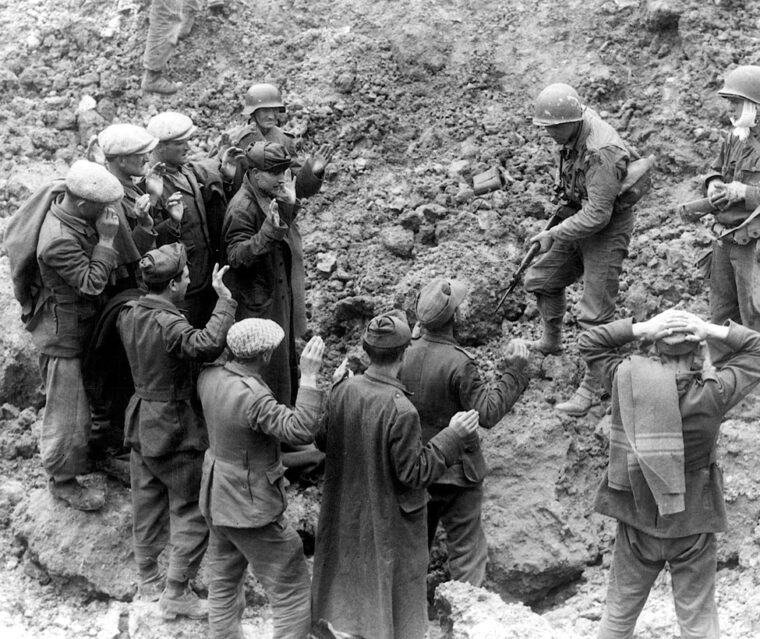
Sergeant Nathan Fellman, an ammunition specialist with the 12th Regiment, got separated from his unit soon after landing. Linking up with some paratroopers from the 101st Airborne, he moved warily through the French countryside. Two German snipers in a tree almost got Fellman, but the paratroopers cut them down with a burst of fire. Continuing on, the men came to a barn beside a trail. Two paratroopers ran up and pitched a hand grenade inside. Before it could explode, five German soldiers rushed out with their hands up, yelling, “Kamerad!” The men were lined up while the paratroop commander wondered aloud what to do with them.
“Kill them,” another paratrooper said, and the Germans were mercilessly mowed down, “Chicago-gangster style,” Fellman recalled. When he asked the sergeant why the men had been killed, “he said his landing instructions were to kill all enemy and he merely followed his orders. There were no provisions for taking captives.” Fellman, who was Jewish, conceded that the sergeant had probably done the right thing, under the circumstances, “but even though I had no love for the Germans, I would rather not have had this experience.”
It was a hard war on both sides. Malcolm Williams, a North Carolinian in the 12th Regiment, remembered being greeted personally by General Roosevelt after his landing craft scraped bottom at Utah Beach. “He said to us, ‘How do you boys like the beach?’” Williams recalled. The rest of the day wasn’t so pleasant. Moving through the now-familiar flooded areas, Williams and his comrades would sometimes step into a hole and sink in over their heads, forcing them to swim for several feet before reaching shallow ground. Ahead, they could hear machine-gun fire coming from the causeway.
Passing through some woods, Williams’ group came upon some dead paratroopers from the 101st and 82nd Airborne, “tied by their feet, hung up a tree and then cut all the way down their bodies with a knife. I also saw where wounded had been tied to a bed and then the house burned down around them.”
Not all sights were so horrific. At Ste.-Marie-du-Mont, a village just beyond Pouppeville, French baker Pierre Caldron had been awakened before sunrise by the sound of gunfire. A German officer had been billeted at Caldron’s home, but had left two days earlier. Looking out his second-floor window, Caldron caught sight of an American paratrooper moving through the yard. The soldier pointed a rifle at Caldron, but fortunately for the Frenchman, he was wearing his white baker’s hat. “I think he must have thought I was a medic from my hat,” Caldron reasoned. The American moved on without firing. At 7 am, a railway guard from the village rushed into Caldron’s house, kissed him on the cheek, and cried, “They’re here! They’re here! They’ve landed, and if you don’t believe me, here’s an American cigarette.” At 10 o’clock the first American infantrymen moved into the village. A stocky soldier with the 4th Division grinned at Caldron and shouted, “Vive la France!” The baker could only nod back—he didn’t trust himself to speak.
By late afternoon, some 22,000 men and 1,800 vehicles had landed successfully at Utah Beach and churned inland, pushing aside all enemy resistance. At nightfall, the exhausted troopers bedded down at St.-Germain-de-Varreville, Les Forges, and other reassembly points near the vital N17 highway to Cherbourg. Thanks to the swift thinking and unflappable nerve of Roosevelt and his senior officers, the landing at Utah Beach had been a stirring success, made all the more remarkable by the rough handling the other American units had endured at Omaha Beach before they could get through that killing ground.
Major General Thomas Handy, right-hand man to Army Chief of Staff George Marshall, had waded ashore at Omaha Beach to see for himself what the landing was like. “It was terrible along that damned beach,” he recalled. But Utah Beach was a different story. “The performance of the 4th Division was remarkable,” Handy reported. “It was a new division that had never been blooded. We all thought Utah was going to be more of a problem than Omaha—the damned terrain swampy with causeways; one gun at each could stop tanks from coming through.” The Germans never got the chance. Rough Rider that he was (he had been adopted by his father’s regiment and had actually bivouacked with the famous cavalrymen when they returned to America from Cuba in 1898), Roosevelt had not given the Germans time to stop him. True to his word, he had started the war when and where he wanted, and because he did, the Allies had made their first crucial lodgement on the European land mass. From there they would not be driven off.
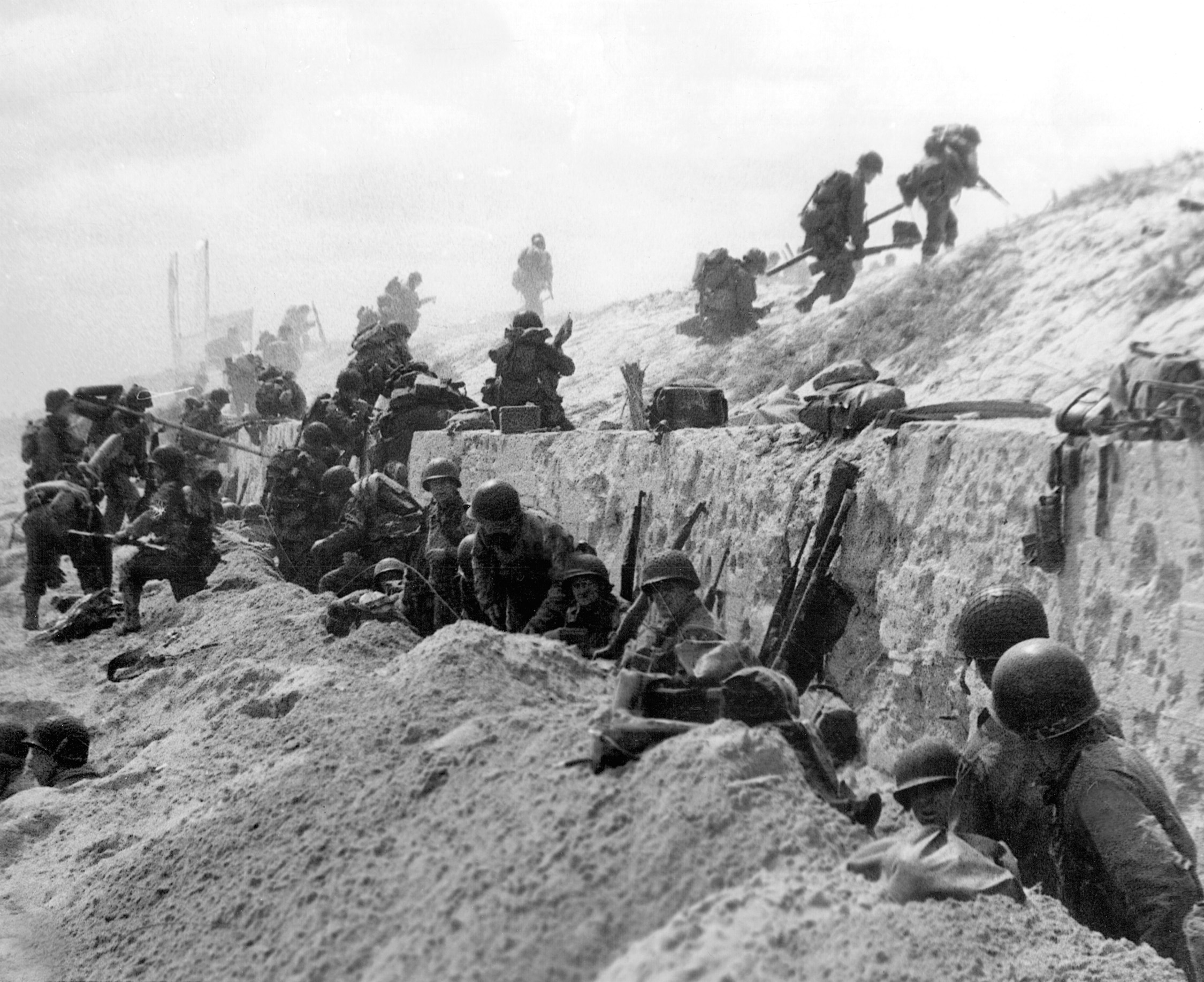
In the weeks that followed, Roosevelt and the 4th Division drove steadily toward Cherbourg, where the Germans put up a strong last-ditch defense. Hedgerow to hedgerow the Americans fought their way up the Cotentin Peninsula, taking heavy casualties as they went. (At Chateau de Fontenay, a 200-year-old mansion situated alongside a pivotal roadway, one company of the 2nd Battalion, 22nd Infantry lost almost as many men in one morning as the entire division lost in the day-long landing at Utah Beach.)
Accompanied by the 9th and 79th Divisions, which had landed a few days after D-day, the men of the 4th slogged steadily onward. Roosevelt, as usual, was in the midst of things, serving for a time as military governor of Cherbourg after the vital port city surrendered on June 26. He relinquished his quasi-political post to rejoin the division as it took part in the breakout campaign to capture St. Lô and drive ever deeper into Normandy. Along the way he had come into possession of a captured German truck that his men had repainted and turned over to him for a mobile headquarters. It was this truck that Roosevelt bragged about in a letter to his wife Eleanor (not the Eleanor Roosevelt who was married to his cousin, Franklin) on July 10.
“The truck arrived yesterday at a most opportune moment,” Roosevelt reported, “for the old chassis had begun to feel the strain of these last few years of combat. I was a pretty sick rabbit.… The Doc came and said with a little embarrassment that my troubles were primarily from having put an inhuman strain on a machine that was not exactly new. Anyhow, he gave me something to make me sleep, and this morning I was almost as good as new.”
The next day, Roosevelt put in a full day’s work in the field, then retired to his little truck to rest. He was overjoyed by a surprise visit from his son Quentin, a young lieutenant with the 1st Division who had landed at Omaha Beach on D-day (the Roosevelts were the only known father and son team to accomplish that feat). The two spent the better part of three hours catching up. “We talked about everything—home, the family, my plans, the war—having a swell time,” Quentin wrote to his mother. “He hadn’t expected me to drop in and was terribly happy when I left him, as I was.” Later that night, Roosevelt died peacefully in his sleep in the back of his truck, the victim of a massive heart attack.
Unknown to Roosevelt, at the time of his death the paperwork was waiting to be signed by General Dwight D. Eisenhower promoting him to major general and giving him command of the 90th Division. Instead, on Bastille Day, July 14, Roosevelt was buried with full military honors at Ste.-Laurent-sur-Mer. Omar Bradley, George S. Patton, Raymond Barton, and three other general officers stood at attention while enlisted men from the 4th Division carried the flag-draped casket to its rest.
Two months later, President Roosevelt presented the general’s widow with her husband’s posthumous Medal of Honor at a private ceremony at the White House. The citation praised Roosevelt “for gallantry and intrepidity at the risk of his life above and beyond the call of duty” at Utah Beach on June 6. “His father would have been proudest,” the president said. (TR, too, would eventually receive a posthumous Medal of Honor for his heroic performance at San Juan Hill, making the Roosevelts the second father and son to win Medals of Honor after General Douglas MacArthur and his father, Lieutenant Arthur MacArthur.) Ted Junior would have been prouder still of the tribute paid to him years later by his old commander, Omar Bradley. When asked by a reporter what was the single bravest feat he had ever witnessed in his long career, Bradley said simply, “Four words: Ted Roosevelt. Utah Beach.”n
Noted author Roy Morris, Jr., lives and writes in Chattanooga, Tennessee. His latest book, Fraud of the Century, describes the circumstances surrounding the disputed U.S. Presidential election of 1876.
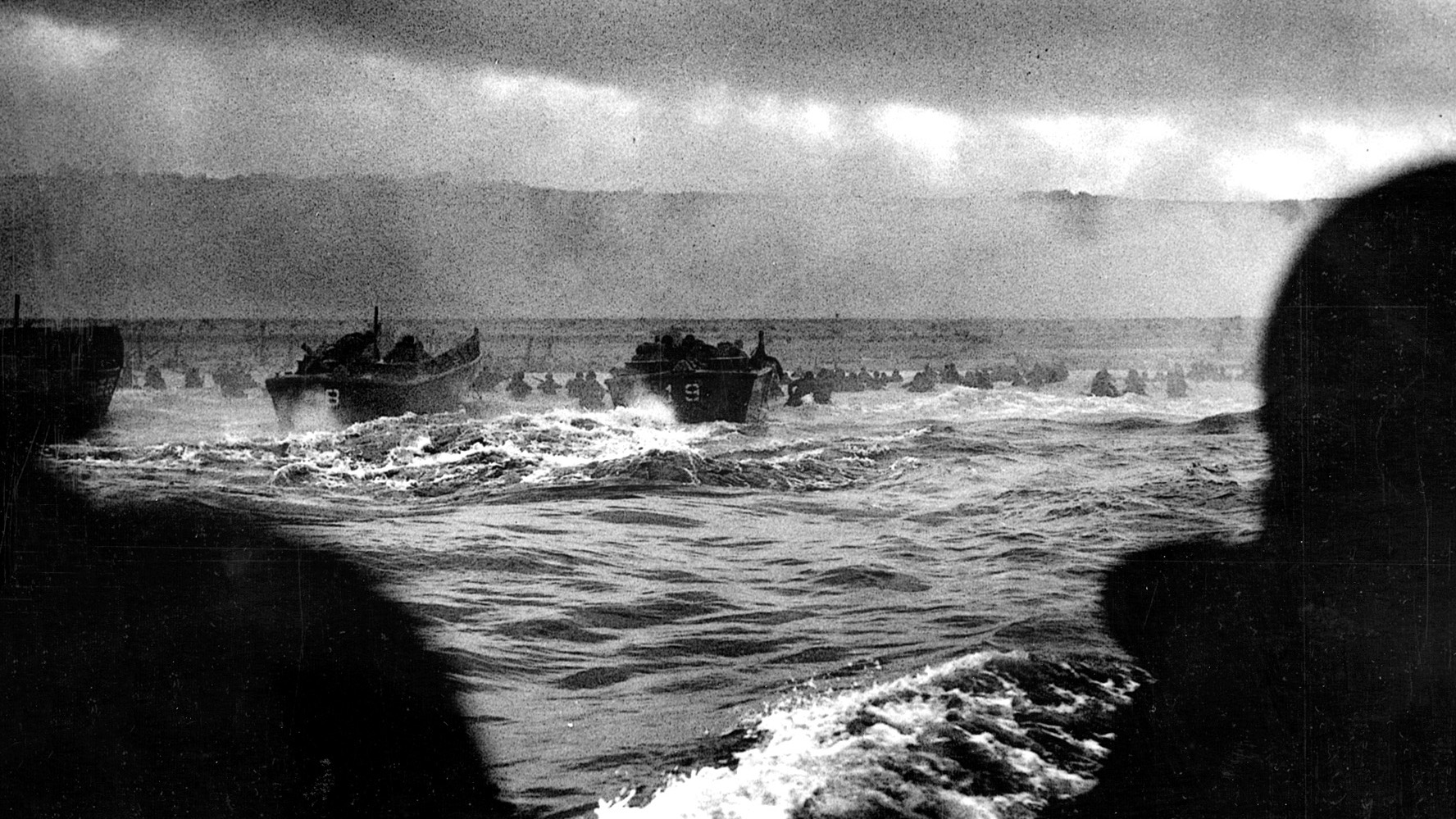
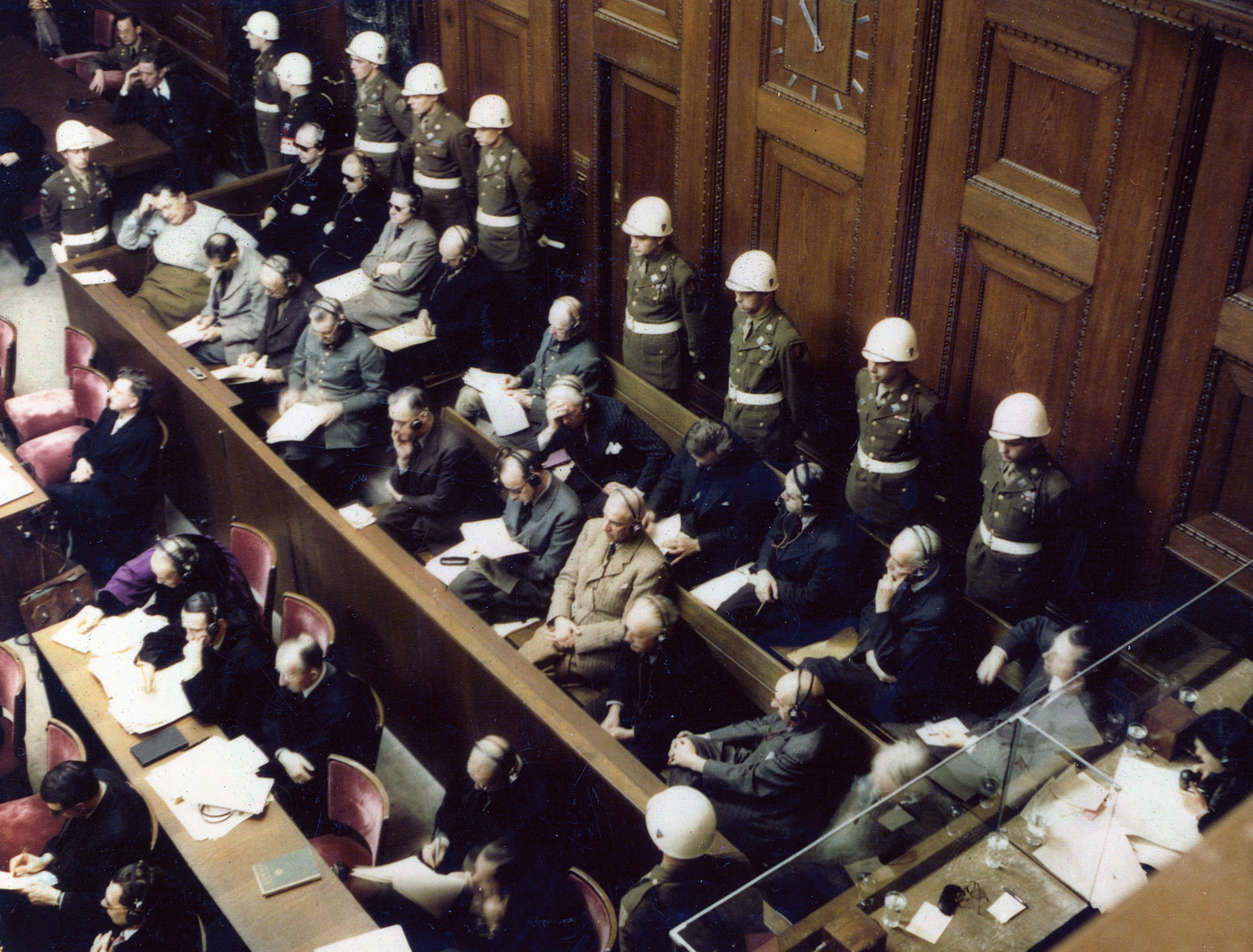
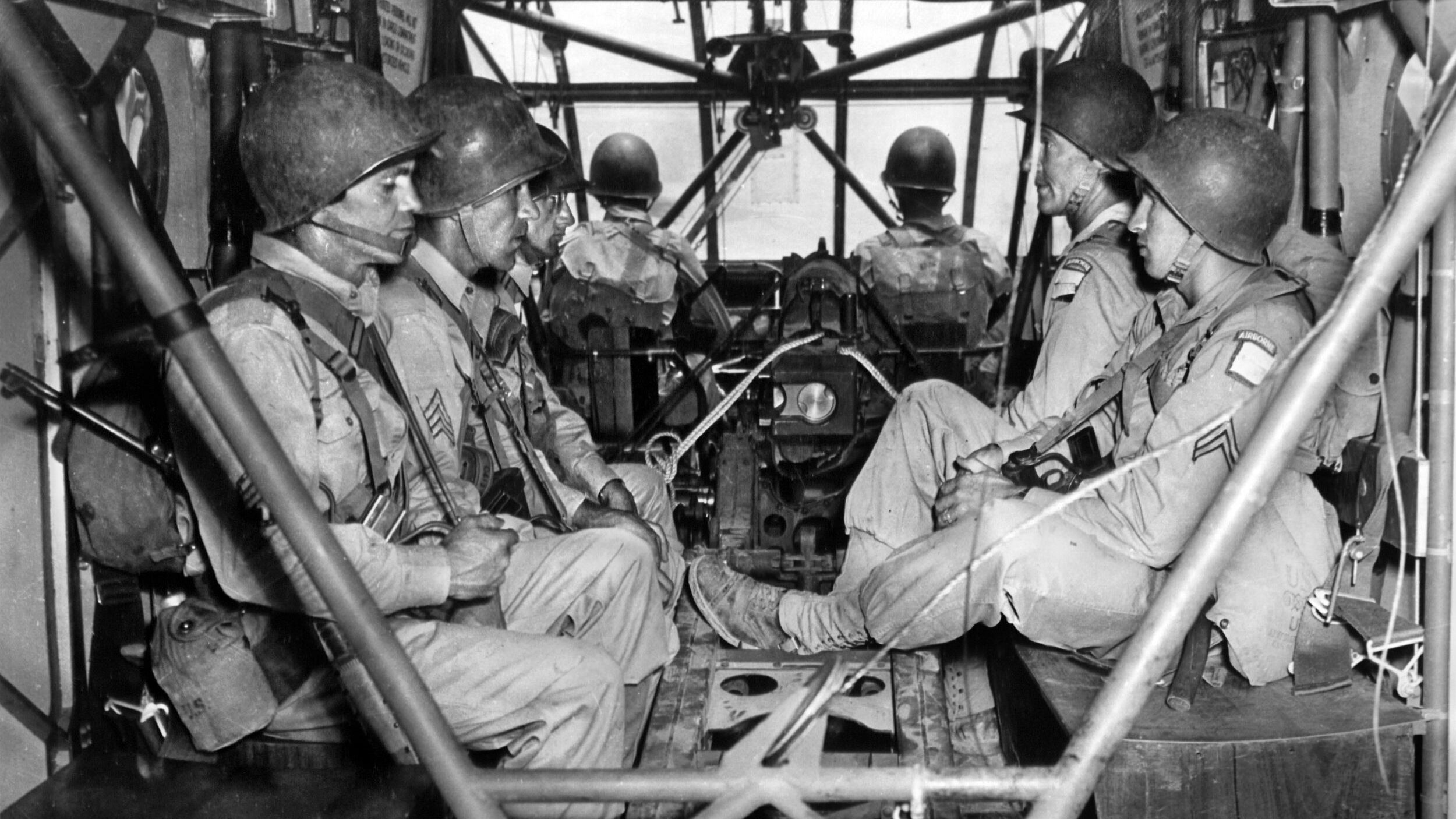
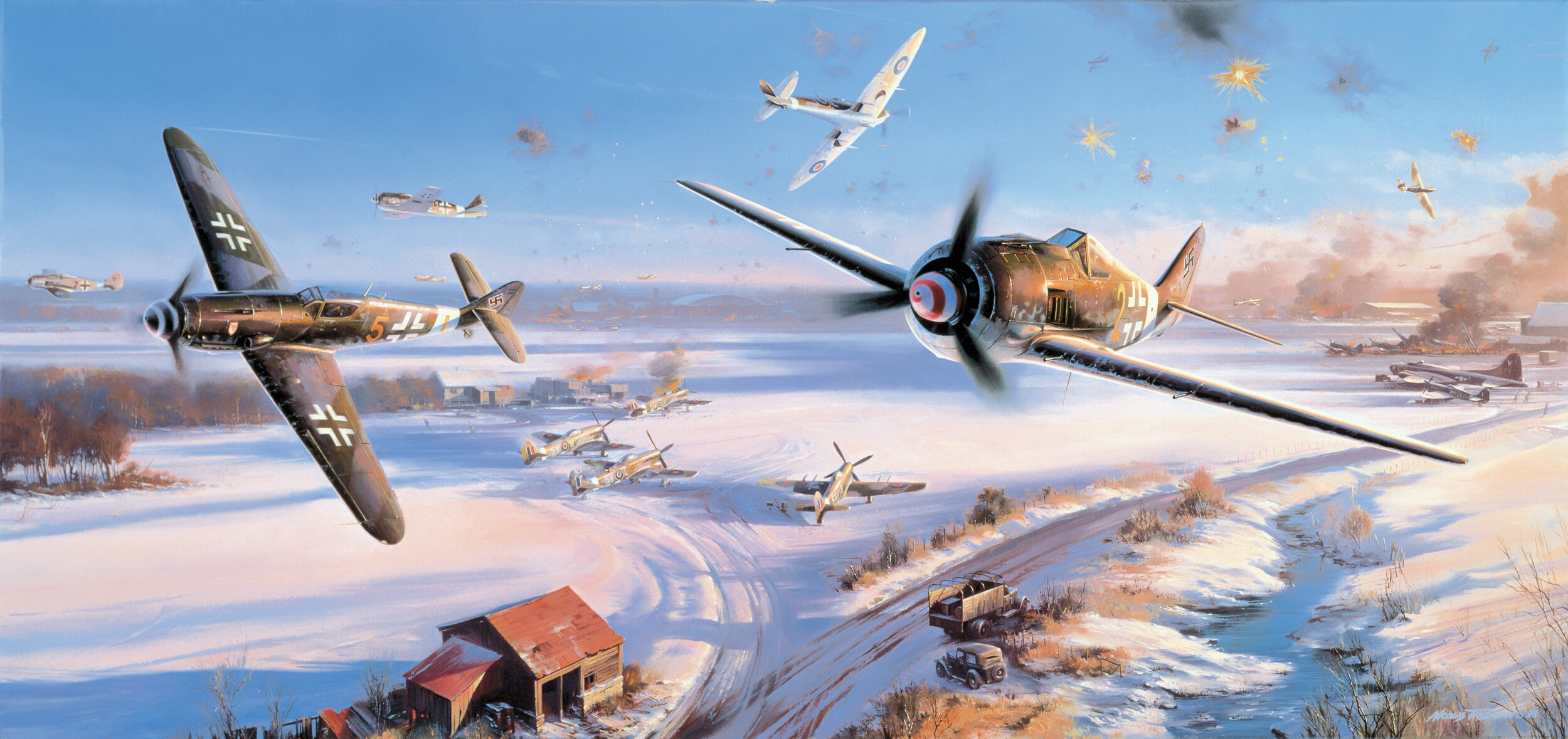
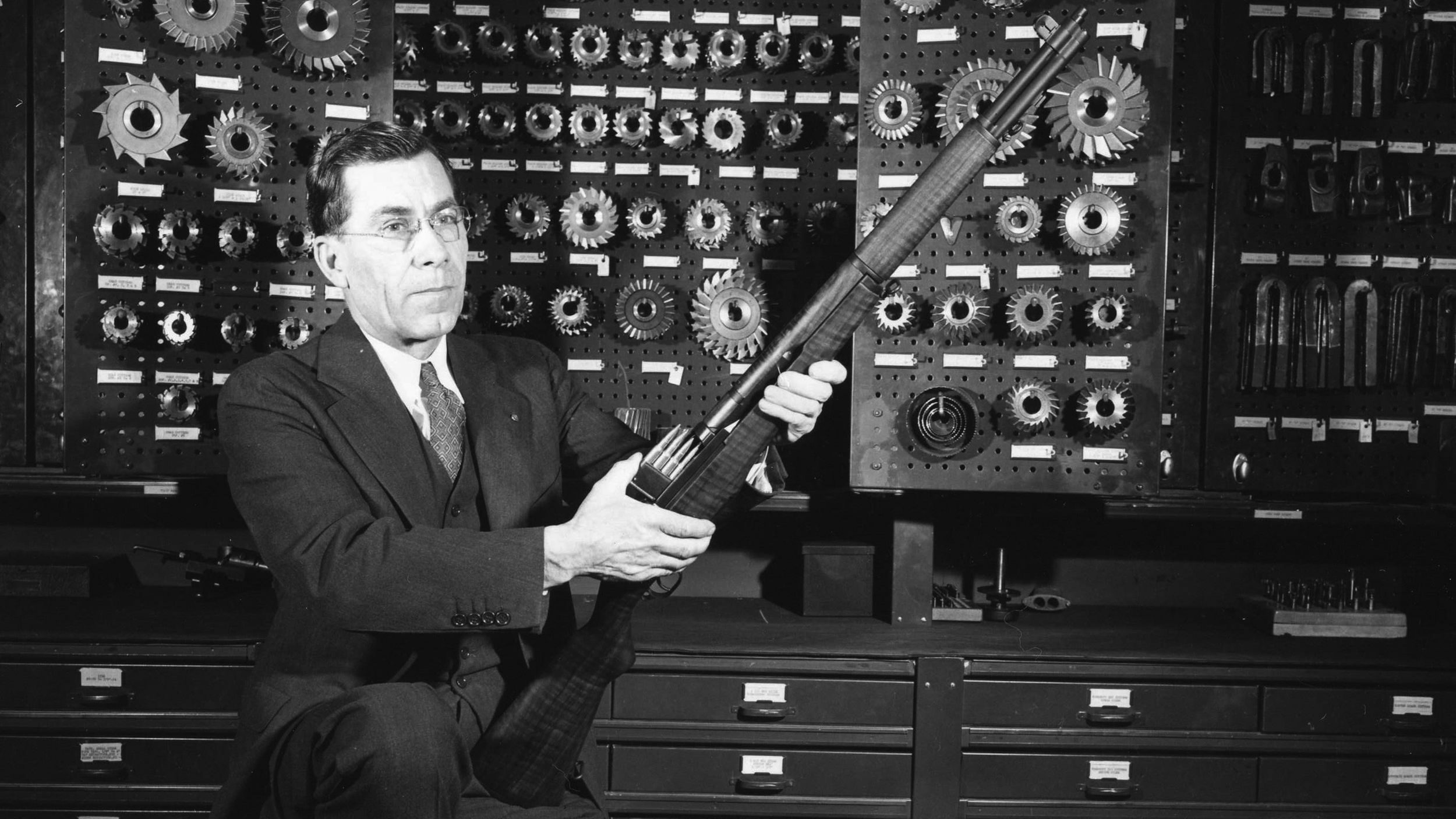
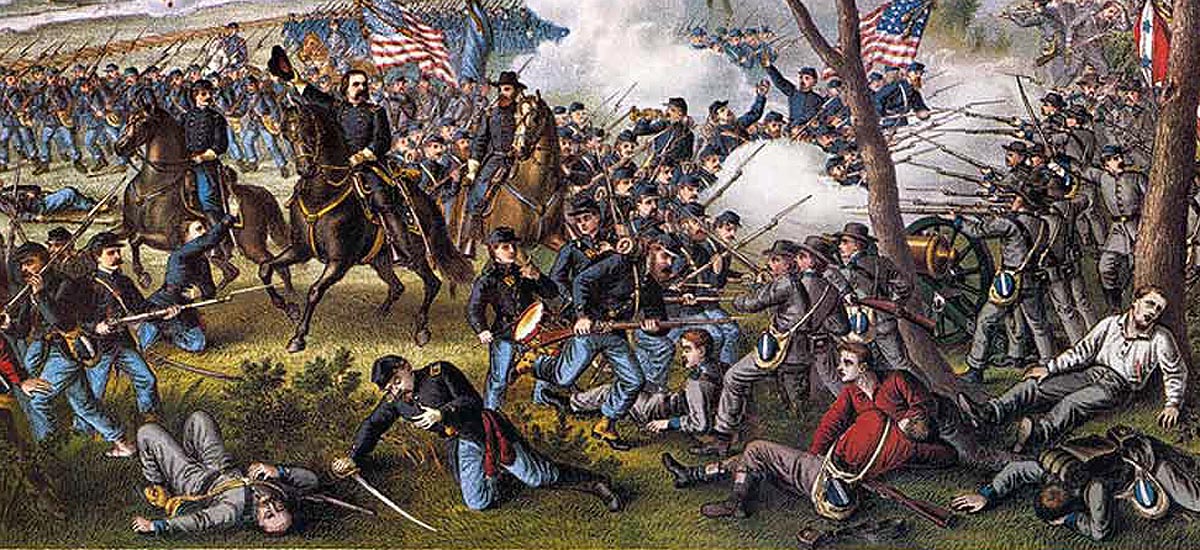
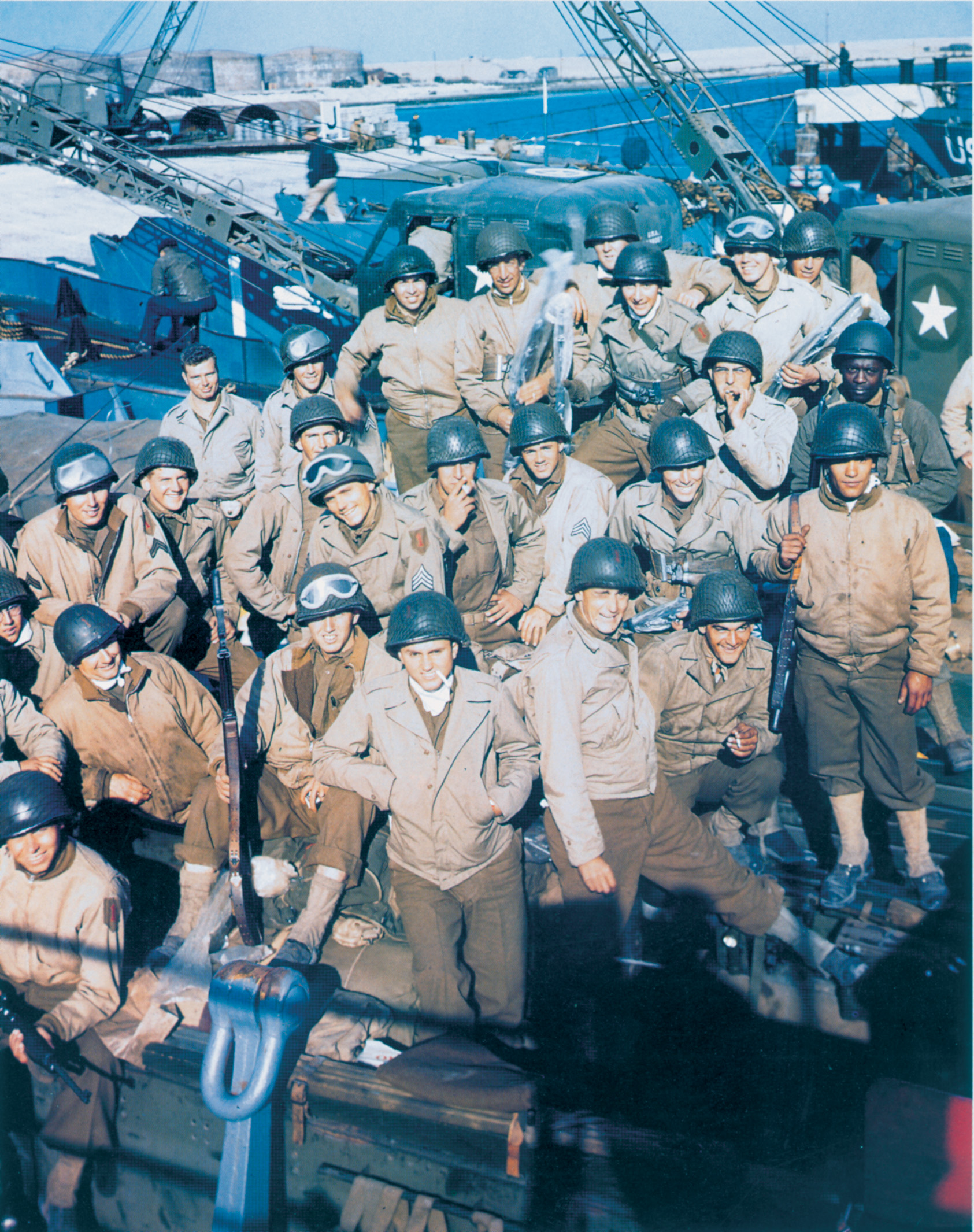
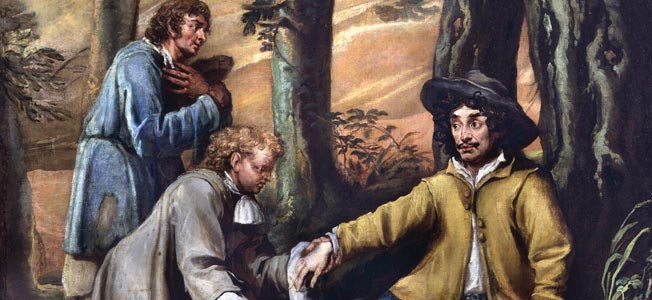
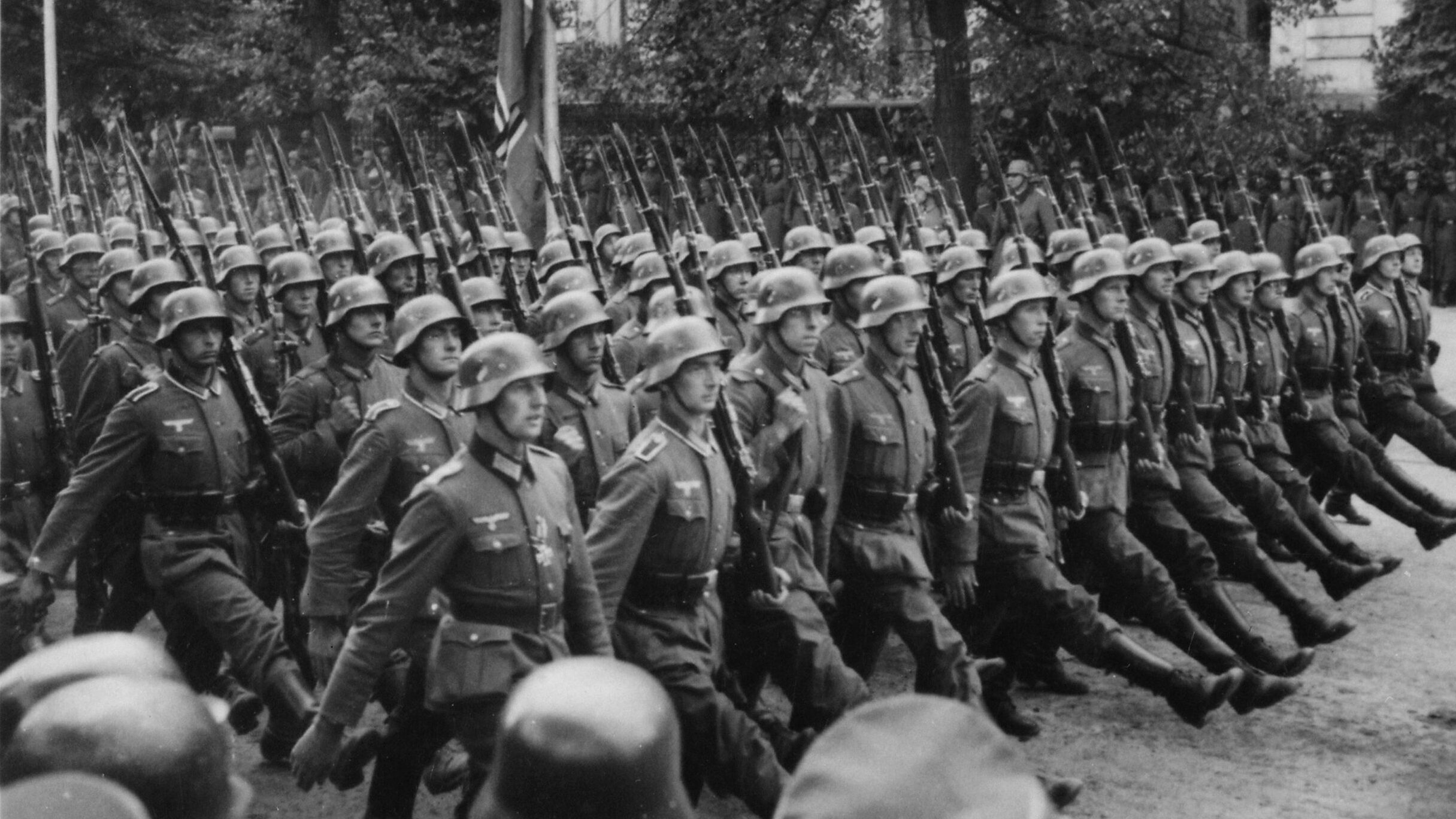
Look carefully at the photo of the GI with his prisoners…two of them are wearing Italian Army uniforms.